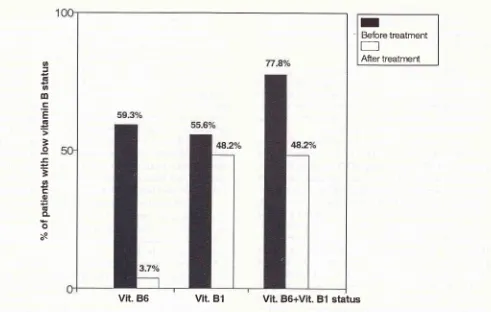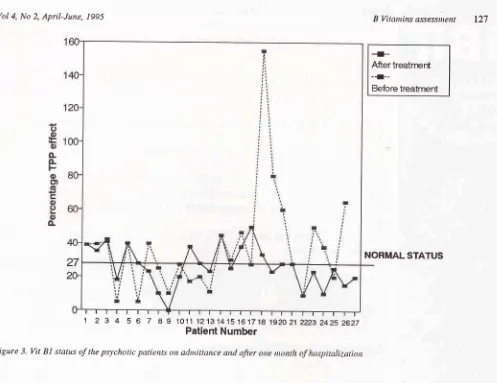Vol 4, No 2, April-June, 1995 B Vitanins assesstr,enl t23
vitamin
86 and
vitamin
Bl status
in
Acute psychosis
Jos Utama*, Hera G. Tamara**, Drupadi
Dillon***,
Evi Setiadi****,
Wilmar Musram****
Abstrak
Pada pertengahan abad ke-20 konsep biopsikiatri sebagai dasar penyakir jiwa mulai dikenbangkan. Telah ditenwkan beberapa zat kimia seperti LSD (lysergic acid
diethylan
dapatnenintbullan
psitosrs.
IjlD
dan serotonin (5HT) nenpury-ai strukturya
hasil penguraianse
inyaisifa
yangaupuh. Diketahuipulabahwasintesisserotonindannorepinefrin(NE)nutlaknenerlukanpiridol<satfogùtlfipl,bentukaktifvinntin
86, sebagai kofaktor' Hingga sekarang kepastian nengenai perubahan SHT dan NE pada pendirnàp.ritosis nnsih belunt dapat disimpulkan. Tuiuan penelitian kani ialah untuk uengetahui perubahan status vitatnin 86 dan vitanûn BI penderita dengan berbagai tingkat kegowatan keadaan psil<osrs. .I/osil senentara nenuniukkan bahwa sraus vitantin 86 langsung beihubungan deigan keadaan psikosis sedangkan status vitanùn Bl tidak
Abstract
In the nidst of our century, the biological concepl of the pathogenesis of ntental illness was launched. Several agents were discovered that nûnûc the sy,,tpton$ of nental disease like I,J,D (tysergii acid diethylanûde) and reserpine. It v,asfound that Ij,D and
serotonin (5HT) were structurally similar and that the brealcdown products of 5HT had potent halluiinogenic properties.
It was also
known that the ss:nsl16it of 5HT and norepinephrine (NE) were pyridoxatphisphate (Pip), the active fttrtn of-vitàtnin 86, dependent.However,
definitiv
resent stillinc
I of our srudyis to lookfor
chan
the diferents
prelintinaryfindings show
that
dependent while vitantinBï
stutus is not.Key words : acute ps),chosis, serotonin, norepinephrine, vitatnin 86 and vitauin
Bl
status.INTRODUCTION
In the midst of our century, several relatively effective
and
selective drugs
for
the
management
of
schizophrenia and manic-depressive patients werein-troduced. This
condition stimulated the biologicalconcept of the pathogenesis of mental illness. In addi-tion, other agents were discovered that mimic some
of
the symptoms of mental illnesses. These include lyser-gic acid diethylamide (LSD) which induces hallucina-tions and altered emotional states and antihypertensiveagents, such as reserpine, which can cause depression.
At
the same time,it
was noted that serotonin (5-hydroxytryptamine, 5HT) and LSD were structurally similar and that breakdown products of 5HT, such asdimethyltryptamine, had potent hallucinogenic
properties.'
These observations led to speculations that a deficiency of amine neurotransmitters (NT) inthe central nervous system (CNS) might be causative
of depression or that an excess could result in mania. Further, since antipsychotic agents antagonize the ac-tions of dopamine (DA) as a NT in the forebrain, it was
Departnent of Neurology, I ndo nes i a, J akarta, I nd o nesi a.
'-..
124
Utann et alproposed that there may be a state of functional over-activity of DA in the limbic system or cerebral cortex in schizophrenia or mania.
Until the mid 1960s the only known NTs were a handful of biogenic amines. In the late 1960s the role
of
amino acids, such as gamma aminobutyric acid (GABA), glycine and glutamate, as NTs became ap-parent. The decade of 1960 witnessed the appreciationof
peptides asNTs.
Although peptides represent the most diverse group of transmitters, yet the amino acids are the most abundantNTs. GABA,
the mostin-hibitory NT,
accountsfor
25-40%of
synapses, depending on the brain region.During early development, a rapid and massive death occurs among the postmitotic neurons whose axons have reached and connected
with
their target territory. 2'3 Th" ability of neurons to survive through this developmental death period has been hypothesizedto
depend on target-derived neuronotrophic factors, which taken upby
the axonal terminals and used to stimulatelife
supporting cell activities. The concept of a nerve growth factor (NGF) was born, and in the 1960s its existence and general properties were estab-lished by Levy-Montalcini et al.ap
The discoveryof
NGF has been a milestone
in
modern neurobiology. We know now that NGF is critical for the survivalof
certain neurons as well as
for
the outgrowthof
their neurites and thatit
also stimulates the synthesisof
transmitter producing enzymes. Glial cells surround -and greatly outnumber - neurons in both the peripheral nervous system (PNS)-
(satellite and Schwann cells)and
the
CNS
(astroglia,
oligodendroglia
and microglia). Certain roles of glial cells have long been recognized eg, electrical insulation (myelin), histologi-cal organization (radial glia, glial lining) andmonitor-ing
of
extracellularfluid
composition (blood -brain -barrier). The discoveryof
very close anabolic and metabolic interrelations prompted Hyden etal,6
to propose the concept cf a glia-neuron functional unit.Further analyses have revealed the ability of glial cells
to
produce and release neuronotrophic agents, like pyruvate, and their ability to respond to neuronal signals,T'8It
is also known, that the B vitaminsespe-cially
the vitamins Bl, E}6,Bl2
andfolic
acid are essential cofactorsfor
the normal activitiesof
cell neuronsand
their
axons,including
regenerative processes.A
deficiencyof
vitaminB
complex may resultin
disturbancesof
functionof
both the PNS (nerve conduction velocity) and CNS (higher corticalfunctions) as
well
as the
synthesisof
NTs
like serotonin and GABA.In
spiteof
much work, definitive findings con-cerning the 5HT and NE alterations in psychotics areNed J Indones
at present still inconclusive. The key problem has been the absence of good methods for examining localized NT and functional changes, However, as the synthesis of 5HT and NE is vitarnin 86 dependent, estimation
of
vitamin 86 and vitaminBl
status in the diverse stagesof
psychosis could provide us more information.We hypothetize that, metabolic and nutrient requirements in acute psychoticswill
be higher than under normal conditions, consequently vitamin86
and vitamin B1 statuswill
fluctuate according to the acuteness of the illness. The objective of this study is to look for altera-tions between the vitamin 86 and vitamin B1 status and the stage of psychosis of the patients.METIIODS
The material consisted of 27 acute psychotic patients, 16 males and 11 females, ages between l7-60 years.
All
cases were new inpatients, admitted for at least one monthin
the State Mental Hospitalof
Bogor, West Java,with
pure mental illnesses. The examination consistedof
general physical diagnostics, clinical néurological and mental assessment, routine blood and vitamin 86 and vitaminBl
status. The examinations had been done twice, prior to the treatment, directly at the tinre of adnrittance and secondly, after one month of hospital treatment. Standard psychotic medicationswere chlorpromazine,
diazepam, carbamazepine parenterally andorally,
besides phenobarbital and trihexyphenydil tablets for epileptic insults and parkin-sonism.The vitamin
Bl
status was expiessedin
the thiamine-pyrophosphate (TPP) effect which is deter-mined by the methodof
Schouten, a modificationof
the Dreyfus test.e
Vitamin
86
statusis
determinedby
the
ery-throcyte aminotransferase (EAT) activity test and ex-pressed in the coefficient of EAT activation (CA) l0).In previous studies a TPP effect < 27 % and a CA < 1.40 were found fora normal vitamin
Bl
and vitamin 86 status, respectively.g't0 Th" TPP value greater than 277o and thatof
CA
greater than 1.40 indicate the deficiencyin
vitaminBl
and86
respectively. The t-test was usedto
compare the TPP andCA
values before and after treatment.RESULTS
Vol 4, No 2, April-June, 1995
assessment revealed schizophrenia
oses including one epileptic and th.ree
cases,
all
werein
an acute anxietywere normal before and after treatment.
status
patients (77.8%) (Figurel).
A
secon
the same patients, one monthlater,
al vitamin -86.tut*
forall but
one
patient
re 2), with a slightimprove-ment
of
the
statusfor
2 patients (7.4%)(Figure
3),
he vitamin86
statusof
thepatients
D) andafter on
sD),
t
?'3:
0.0005)
of the
patients prior to treatment
(%
Tpp effect=
37.11t
31.07) (xt
one month of treatment (%TPP
effect
72) (xt SD),
rhe differenceis just
signi
p < 0.05).DISCUSSION
tenance, the normal
tbe nervous system.
lowances
(RDA)
foperiodically revised by the Dietary Allowances Com_ mittee
of
the Food and NutritionBoard.
These al_t levels sufficiently high to cover the
I healthy individuals in their age and
vels are set high because the exact
allowance,
will
not necbut the
risk
of
becomiintake
is
less than themended.
B Vitarttitts assessiltent 125
rncrease( tissue tequirûme,ntt
for
vitaminsnny
cause a nutdtiona\ delïcïency to deve\op, despite the
ingestion
ofa
diet that had previously been adequate.For example, requirements for some vitamins mày be
altered by the use of certain antivitamin drugs, such as the interference wirh the utilization
of
folic
acid by trimethoprim.ll
Dir"ur".
associated with an increasedmetabolic rate, such as hyperthyroidism and condi_
tions accompanied
by
feveror
tissue wasting, also increase the bodys requirementsfor
vitamins.
Theimpact
of disease
on requirementsfor
nutrients may vary according to its phase and intensity. The need for therapywith
vitamins may change ihroughout thecourse
of
the illness and eventually, cure should beassociated with a tapering down of the vitamin therapy.
The
induction
of
convulsive
seizures
bypyridoxine deficiency may be the result of a lowered concentration of
GABA.
Glutamate decarboxylase, a pyridoxal phosphate requiring enzyme, catalyses thesynthesis of this inhibitory CNS neurotransmitter. In addition, pyridoxine deficiency leads to decreased con_
centrations
of
the
neurotransmitters
NE
andserotonin.l2 The dramatic improvement of the vitamin 86 status, the rapid shifting lrom a deficient state to an almost normal condition, indicates a direct connection between the vitamin 86 status of the patients and the course of the disease.
As PLP is an essential cofactor for the synthesis
of serotonin and NE, a fluctuation
in
the vitamin 86status may result in similar changes
in
serotonin andNE
levels. An increase
or decreasein
the serotoninand NE levels of psychotic patients is dependent both
upon the vitamin 86 status and the phaseànd intensity of the mental process. An acute psychotic patient re_
quires a higher amount of nutrients and subsequently
will
have a low vitamin86 status,
resultingin
lowerlevels of serotonin and NE. On the other
haù,
chronicand stable psychotics
will
require less nutrients.Thus an adequate vitamin B6 status together with an average normal diet
will
produce normal to high normal serotonin and NE levels in these patients. Al_though some preliminary findings are supporting these
conclusions, yet because
of
the limiteâ material, anevaluation
of
more patients overa
longer periodof
time together with a more extensive study-would be the answer,
We conclude that the vitamin
86
statusof
thepatierrts.is fluctuating paradoxically
to
the stageof
psychosis. The higher the state of mental disintegra_ tion the lower the vitamin 86 status of the patients.
No dramatic change is found
in
the vitamin 817
t26 Utann et al Ned J Indottes
I
Before treatment
E
Aftertreatment
[image:4.595.63.554.70.382.2] [image:4.595.61.554.394.712.2]Vit.
86
Vit.81
Vit. B6+Vit. 81 statusFigure
l.
Histogratn of the psychotic patientsu,ithlowvit. BI,vit. 86 and aconrbined lowvit. Bl and 86statusbeforeandafier treattnent.
NORMAL STATUS
-f-After treatrirent
--l--Before treatment
12 8 9 lO11 '121314 15 161718 192021 22324252627
Patlent Number
Figure 2. Vit 86 sraus of rhe psychotic patie,ils otr rulnittance aatd afier one uonrh of hospitalizatiott
o
J G o
lD .E E lE -Ë
3
-9
Ë
3 o
c
.9
(g CL
o
s
o
L
o
G
.E o
o
tr .9o
oo
Vol 4, No 2, April-June, 1995
1
2
3 4
56 7 I I
1011 1213141516.t7.t8 1920212?2324252627 [image:5.595.52.549.38.421.2]Patient Number
Figure 3. Vit 81 status of the psychotic patients on adtnittance and after one nrcnth of hosl italizatiott
REFBRENCES
1. Carlsson A. Early psychopharmacology and the rise in
modern brain research, I Psychopharmacol 1990;4:120-6. 2. Cumingham TJ. Naturally occurring neuron death and its
regulation by developing neural pathways. Int Rev Cytol 1982;74:163-86.
3. Hamburger
V.
OppenheimRN.
Naturally occurring neuronal death in vertebrates. Neurosci Comrnent 1982;l: 39-55.4. Levi-Montalcini
R.
Developmental neurobiology and the natural history of nerve growth factor. Annu Rev Neurosci1982;5:341-61.
5. Levi-Montalcini R. Angeletti
PU.
Nerve growth factor. Physiol Rev 1 968 ;48 :534-69.6. Hyden H. RNA in brain cells. In: Quarton GC. Melnechuk
T. Schmitt FO. editors. New York: Rockefeller Univ press
1967;248-66.
B Vitanins assessilrcnt r27
{-Aftertreatrnent
--l--Before treatment
NORMAL STATUS
7. Selak I. Skaper SD, Varon S. Pyruvate participation in the
low molecular weight trophic activity for CNS neurons in glia-conditioned media. f Neurosci 1986;5:23-8.
8. Varon S. Skaper SD. Facci L. Rudge
I.
Manthorpe M.Trophic and metabolic couplings between astroglia and
neurons. In: Althaus H. Seifert W. editors. Glial-Neuronal Communications in Development and Regeneration. New
York: Springer 198 6;49 l-504.
9. Setiadi E, Musram W, Hamopidjari D, Djalil H. Efek Tpp
(tiaminpirofosfat) dan konsumsi
vit
B1 sekelompok mahasiswa. Maj Kedok Indon l99l;41,645-8.10. Musram W. Penetapan status vitamin
86
dengan ujiaminotransferase eritrosit. Maj Kedok Indon 1994; 44,
154-7.
I
l.
Roe DA, Drug interference with the assessment of nutrition-al status. Clin I-ab Med 1981;l:647-64.12. Dakshinamurti K. B vitantins and nervous system function,
In:
Wurtman RJ. Wurtrnan IL editors. Nutrition and the
